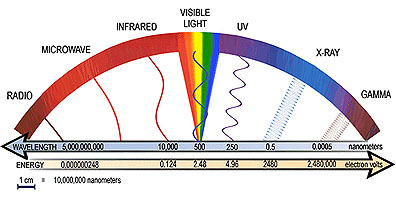
http://chandra.harvard.edu/resources/em_radiation.html
EM waves are defined to be
"self-sustaining oscillation of the electromagnetic
field." To be self-sustaining, they take on the form
of transverse waves, and are the product of two
concepts: the electric field and the magnetic field.
A man by the name of Michael Faraday discovered in 1831 that by having a changing magnet field around a conductor, one could produce an electrical current. However, there must be some sort of force to act upon the charge carriers in the conductor. Therefore, we can infer that in order for there to be an induced current, there must be an induced electric field to cause the current. Later, in 1855, a physicist name James Clerk Maxwell hypothesized that by having a changing electric field, there was an induced magnetic field. He then went further with his hypothesis, stating that it would be possible, supposing that a changing magnetic field causes an electric field and a changing electric field causes a magnetic field, that a wave could be created that was self-sustaining, provided that both the field were not only perpendicular to each other, but also perpendicular to the direction in which the wave is traveling.

http://mysite.du.edu/~lconyers/SERDP/Figure5.htm
In this diagram, the EM wave would be propagating along the long axis.
A man by the name of Michael Faraday discovered in 1831 that by having a changing magnet field around a conductor, one could produce an electrical current. However, there must be some sort of force to act upon the charge carriers in the conductor. Therefore, we can infer that in order for there to be an induced current, there must be an induced electric field to cause the current. Later, in 1855, a physicist name James Clerk Maxwell hypothesized that by having a changing electric field, there was an induced magnetic field. He then went further with his hypothesis, stating that it would be possible, supposing that a changing magnetic field causes an electric field and a changing electric field causes a magnetic field, that a wave could be created that was self-sustaining, provided that both the field were not only perpendicular to each other, but also perpendicular to the direction in which the wave is traveling.

http://mysite.du.edu/~lconyers/SERDP/Figure5.htm
In this diagram, the EM wave would be propagating along the long axis.
Wave Physics
Radar, Part 1
Radar, Part 2
Lidar
Bibliography
Tl;dr